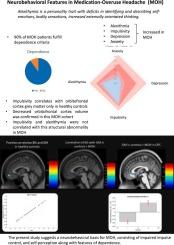药物滥用性头痛的神经行为特征
Q3 Neuroscience
引用次数: 0
摘要
背景用药过度性头痛(MOH)与一系列依赖行为和眶额皮层功能受损有关。自闭症是一种在识别自我情绪和感知方面存在缺陷的特征。材料和方法由一名精神科医生使用临床自控力量表(BIS-11)和情感淡漠量表(TAS-20)对一家三级头痛诊所的符合ICHD标准的慢性偏头痛和MOH患者以及健康对照组进行调查,并根据DSM-IV标准筛查依赖行为。使用基于 SPM 的工具箱 CAT12,利用在 3 T 扫描仪上获取的高分辨率 T1 加权核磁共振成像序列,分析了 BIS-11 和 TAS-20 与大脑灰质的相关性。MOH患者的冲动性(62.2 ± 11.1 vs. 55.7 ± 7.2; p = 0.007)和情感淡漠性(49.8 ± 14.8 vs. 38.0 ± 6.5; p < 0.001)增加。仅对女性进行分析,结果仍然显著。90%的患者符合 DSM-IV 药物依赖标准。在健康对照组中,冲动性与左眶中回灰质呈正相关,而在患者中则没有(p < 0.05,校正后)。结论本研究表明,MOH 的神经行为基础包括冲动控制能力受损、自我感知能力下降以及药物依赖特征。虽然MOH人群的眶额皮质体积减少得到了证实,但冲动和情感淡漠与这种结构异常无关。本文章由计算机程序翻译,如有差异,请以英文原文为准。

Neurobehavioral features in medication-overuse headache
Background
Medication-overuse headache (MOH) has been related to the spectrum of dependence behavior and impaired orbitofrontal cortex function. Alexithymia is a trait comprising deficits in identifying self-emotions and perception. It was the aim of the study to investigate impulsivity and alexithymia, in patients with MOH and perform correlations with cerebral grey matter.
Material and methods
Patients with chronic migraine and MOH according to ICHD criteria from a tertiary headache clinic and healthy controls were investigated by a single psychiatrist, using clinical scales for self-control (BIS-11) and alexithymia (TAS-20) and screened for dependence based on DSM-IV criteria. Correlations of BIS-11 and TAS-20 with cerebral grey matter were analysed with the SPM based toolbox CAT12, using high resolution T1weighted MRI-Sequences acquired on a 3 T scanner.
Results
MRI data were available from 30 MOH patients (24 women) and 47 healthy controls (26 women). MOH patients had increased impulsivity (62.2 ± 11.1 vs. 55.7 ± 7.2; p = 0.007) and alexithymia (49.8 ± 14.8 vs. 38.0 ± 6.5; p < 0.001). Analyzing only women, the results remained significant. Ninety percent of patients fulfilled DSM-IV criteria for substance dependence. There was a positive correlation between impulsivity and grey matter in the left middle orbital gyrus in healthy controls but not in patients (p < 0.05, corrected). No correlations with alexithymia and cerebral grey matter were found.
Conclusions
The present study suggests a neurobehavioral basis for MOH, consisting of impaired impulse control, and self-perception along with features of substance dependence. Although decreased orbitofrontal cortex volume was confirmed in this MOH cohort, impulsivity and alexithymia were not correlated with this structural abnormality.
求助全文
通过发布文献求助,成功后即可免费获取论文全文。
去求助
来源期刊

eNeurologicalSci
Neuroscience-Neurology
CiteScore
3.50
自引率
0.00%
发文量
45
审稿时长
62 days
期刊介绍:
eNeurologicalSci provides a medium for the prompt publication of original articles in neurology and neuroscience from around the world. eNS places special emphasis on articles that: 1) provide guidance to clinicians around the world (Best Practices, Global Neurology); 2) report cutting-edge science related to neurology (Basic and Translational Sciences); 3) educate readers about relevant and practical clinical outcomes in neurology (Outcomes Research); and 4) summarize or editorialize the current state of the literature (Reviews, Commentaries, and Editorials). eNS accepts most types of manuscripts for consideration including original research papers, short communications, reviews, book reviews, letters to the Editor, opinions and editorials. Topics considered will be from neurology-related fields that are of interest to practicing physicians around the world. Examples include neuromuscular diseases, demyelination, atrophies, dementia, neoplasms, infections, epilepsies, disturbances of consciousness, stroke and cerebral circulation, growth and development, plasticity and intermediary metabolism. The fields covered may include neuroanatomy, neurochemistry, neuroendocrinology, neuroepidemiology, neurogenetics, neuroimmunology, neuroophthalmology, neuropathology, neuropharmacology, neurophysiology, neuropsychology, neuroradiology, neurosurgery, neurooncology, neurotoxicology, restorative neurology, and tropical neurology.
 求助内容:
求助内容: 应助结果提醒方式:
应助结果提醒方式:


